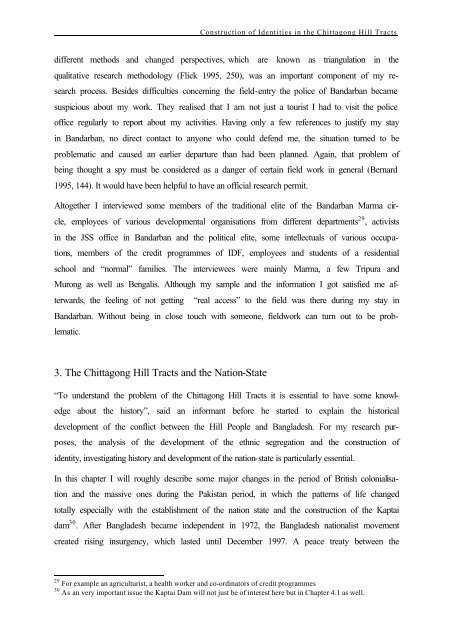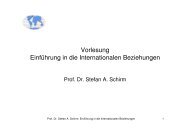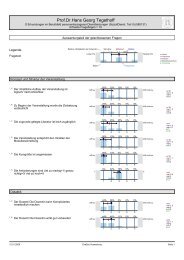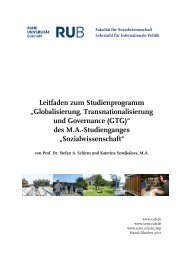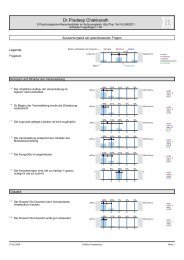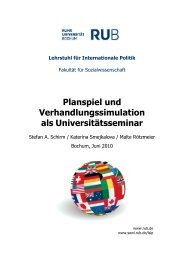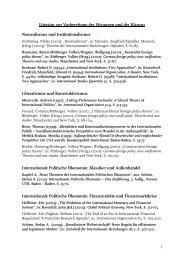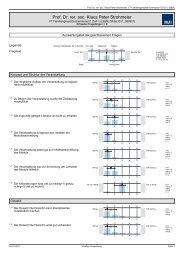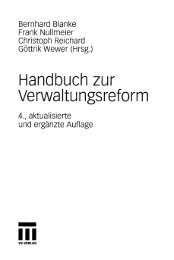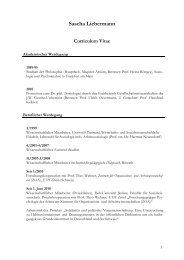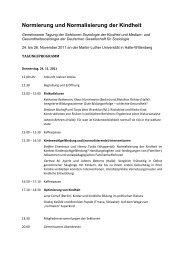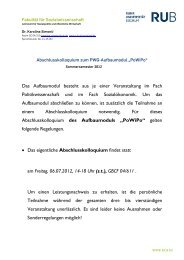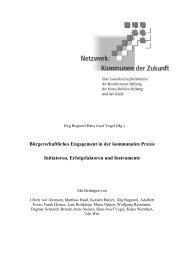Eva Gerharz: âThe Construction of Identities: The Case of the Chitta ...
Eva Gerharz: âThe Construction of Identities: The Case of the Chitta ...
Eva Gerharz: âThe Construction of Identities: The Case of the Chitta ...
Create successful ePaper yourself
Turn your PDF publications into a flip-book with our unique Google optimized e-Paper software.
<strong>Construction</strong> <strong>of</strong> <strong>Identities</strong> in <strong>the</strong> <strong>Chitta</strong>gong Hill Tracts<br />
different methods and changed perspectives, which are known as triangulation in <strong>the</strong><br />
qualitative research methodology (Flick 1995, 250), was an important component <strong>of</strong> my research<br />
process. Besides difficulties concerning <strong>the</strong> field-entry <strong>the</strong> police <strong>of</strong> Bandarban became<br />
suspicious about my work. <strong>The</strong>y realised that I am not just a tourist I had to visit <strong>the</strong> police<br />
<strong>of</strong>fice regularly to report about my activities. Having only a few references to justify my stay<br />
in Bandarban, no direct contact to anyone who could defend me, <strong>the</strong> situation turned to be<br />
problematic and caused an earlier departure than had been planned. Again, that problem <strong>of</strong><br />
being thought a spy must be considered as a danger <strong>of</strong> certain field work in general (Bernard<br />
1995, 144). It would have been helpful to have an <strong>of</strong>ficial research permit.<br />
Altoge<strong>the</strong>r I interviewed some members <strong>of</strong> <strong>the</strong> traditional elite <strong>of</strong> <strong>the</strong> Bandarban Marma circle,<br />
employees <strong>of</strong> various developmental organisations from different departments 29 , activists<br />
in <strong>the</strong> JSS <strong>of</strong>fice in Bandarban and <strong>the</strong> political elite, some intellectuals <strong>of</strong> various occupations,<br />
members <strong>of</strong> <strong>the</strong> credit programmes <strong>of</strong> IDF, employees and students <strong>of</strong> a residential<br />
school and “normal” families. <strong>The</strong> interviewees were mainly Marma, a few Tripura and<br />
Murong as well as Bengalis. Although my sample and <strong>the</strong> information I got satisfied me afterwards,<br />
<strong>the</strong> feeling <strong>of</strong> not getting “real access” to <strong>the</strong> field was <strong>the</strong>re during my stay in<br />
Bandarban. Without being in close touch with someone, fieldwork can turn out to be problematic.<br />
3. <strong>The</strong> <strong>Chitta</strong>gong Hill Tracts and <strong>the</strong> Nation-State<br />
“To understand <strong>the</strong> problem <strong>of</strong> <strong>the</strong> <strong>Chitta</strong>gong Hill Tracts it is essential to have some knowledge<br />
about <strong>the</strong> history”, said an informant before he started to explain <strong>the</strong> historical<br />
development <strong>of</strong> <strong>the</strong> conflict between <strong>the</strong> Hill People and Bangladesh. For my research purposes,<br />
<strong>the</strong> analysis <strong>of</strong> <strong>the</strong> development <strong>of</strong> <strong>the</strong> ethnic segregation and <strong>the</strong> construction <strong>of</strong><br />
identity, investigating history and development <strong>of</strong> <strong>the</strong> nation-state is particularly essential.<br />
In this chapter I will roughly describe some major changes in <strong>the</strong> period <strong>of</strong> British colonialisation<br />
and <strong>the</strong> massive ones during <strong>the</strong> Pakistan period, in which <strong>the</strong> patterns <strong>of</strong> life changed<br />
totally especially with <strong>the</strong> establishment <strong>of</strong> <strong>the</strong> nation state and <strong>the</strong> construction <strong>of</strong> <strong>the</strong> Kaptai<br />
dam 30 . After Bangladesh became independent in 1972, <strong>the</strong> Bangladesh nationalist movement<br />
created rising insurgency, which lasted until December 1997. A peace treaty between <strong>the</strong><br />
29 For example an agriculturist, a health worker and co-ordinators <strong>of</strong> credit programmes<br />
30 As an very important issue <strong>the</strong> Kaptai Dam will not just be <strong>of</strong> interest here but in Chapter 4.1 as well.


